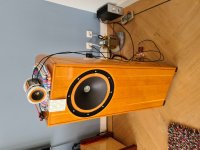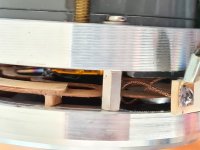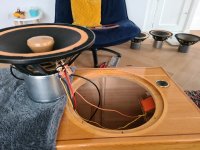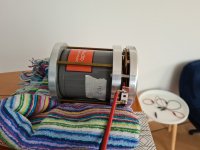The TDA chip is OK, everything is working again!
Aguaazul can relax😀
What a relief! Yes, good team effort.
I think Supersurfers experience is a good reminder of the difficulty of taking on this project and the importance of strictly following a good SMD soldering technique; especially in this case where the supply voltage can easily exceed max voltage spec of the 1541a chip if something goes wrong. My advice is to clean the board with IPA or Acetone before starting and use sufficient amount of extra flux - dont just rely on the flux inside your solder. When finished soldering thoroughly clean off all flux residue with IPA. Acetone may be used but it can damage certain plastics so use with caution. Also use a flux that cleans off easy. I've found that some flux resides can conduct electricity which had me baffled on one occasion for the best part of a day.
I ordered a pair of Sowter 1465 IV transformers as a result of your experiences. Will be delivered in a week or so.
Are you still going to try a balanced setup? Its a great transformer, I dont think it will disappoint.
@All
While on the subject I just want to say that my comparison of the Sowter 1465 and Ivans (Bisesik) tansformers was probably not a very fair comparison (post #1012). Ivans transformers can perform just as well albeit at a lower output level. I never intended to put a fellow diyer down, but I think I may have. So I just want to recognize and extend my gratitude to the great work Ivan has put into his very compact well designed transformers and PCBs. This goes for anyone on this forum that shares their experiences, ideas, and those who lend a helping hand where they can.
@wlowes
I tried your recommendation of using sand in a plastic bag as a way to dampen vibrations effecting the stability of the master clock. This has to be the cheapest and easiest mods you can ever make! The enjoyment factor went up a notch im sure. I think you shared this in one of andrea_mori threads.

re clock and sand
Hey Ryan, thanks for adding this note. I think you may be the only one that has tried it 😉 Good for you. Glad to hear it worked for you. Yes, this one is a no brainer if you have the space and want that little bit extra.
Hey Ryan, thanks for adding this note. I think you may be the only one that has tried it 😉 Good for you. Glad to hear it worked for you. Yes, this one is a no brainer if you have the space and want that little bit extra.
The sand damping of the clock has been a known tweak since the first cd players. It certainly predates the internet.
Yup. I picked it up from a vintage magazine article showing a design for open baffle speakers based on a baffle filled with sand. You could say it's as old as dirt🙂
What a relief! Yes, good team effort.
Are you still going to try a balanced setup? Its a great transformer, I dont think it will disappoint.
I will try both, I read some people like balanced while others prefer 1 chip. With these transformers we can do both.
I also ordered an Aya5 board to see what that will do in comparison (fed with your i2s-PCM board)
The TDA chip is OK, everything is working again!
Aguaazul can relax😀
I ordered a pair of Sowter 1465 IV transformers as a result of your experiences. Will be delivered in a week or so.
Whew!! I'm glad it's up & running.
Cheers,
Aguaazul
I will try both, I read some people like balanced while others prefer 1 chip. With these transformers we can do both.
I also ordered an Aya5 board to see what that will do in comparison (fed with your i2s-PCM board)
Ill be interested in your opinion regarding balanced vs single ended, and also D3 vs Aya5. Please keep us posted.
Did you notice any sound difference when changing R21 to the correct value of 4k7?
Yup. I picked it up from a vintage magazine article showing a design for open baffle speakers based on a baffle filled with sand. You could say it's as old as dirt🙂
And dirt cheap... lol
Ill be interested in your opinion regarding balanced vs single ended, and also D3 vs Aya5. Please keep us posted.
Did you notice any sound difference when changing R21 to the correct value of 4k7?
I will do some extensive testing when all is ready and report in this thread.
I did not test the 2k7 resistor because I had some other project running at the same time (too much changes in my set so I cannot judge separate modifications).
The other project is a field coil tweeter modified with a wooden spider and leather surround, to accompany my 12” field coil with same modification in an open baffle (folded baffle in fact) cabinet. The results are very promising!
Attachments
Is than the 12" from EMS speaker France ? How does it sound ?
Serious drivers you have, cool !
Serious drivers you have, cool !
I will do some extensive testing when all is ready and report in this thread.
I did not test the 2k7 resistor because I had some other project running at the same time (too much changes in my set so I cannot judge separate modifications).
Totally understand, hard to keep track of what part made what difference.
The other project is a field coil tweeter modified with a wooden spider and leather surround, to accompany my 12” field coil with same modification in an open baffle (folded baffle in fact) cabinet. The results are very promising!
That is very interesting! You are one very adventurous diyer! Do you have a thread or a blog about these modifications?
Hi,
Sorry, no thread of this project. These speakers are a design that friends of mine and I are developing for years now, we improve something each year. I think we are nearing the last step of this concept.
@diyiggy: The parts are from EMS loudspeaker from France. I believe you are french?
A friend of mine used to be the importer for these units for benelux (and also Phy from France when Salabert was still alive) and we have good relations with them.
They deliver us the speaker parts from their field coil series and cones modified to our specifications and another friend of mine makes the spider and surrounds. It takes a lot of experimentation (lots of discarded designs) to get the best out of such a construction, but the result is worth it.
The big advantage of this kind of spider is that it reduces the cone distortion a lot; a common spider lets the cone move in all directions, this spider only provides movement on the cone axes, not sideways. If you hear the same 12” with standard spider and with the wooden one the difference is huge: much more focus, openness, less distortion (in the last picture: left one is standard spider, right one new spider)
The field coil is also a much better concept than a conventional magnet, there are 2 advantages; the magnetic field can be made much stronger and it stays constant (no dynamic loss due to the sagging magnetic field of a permanent magnet).
And the third advantage: you gan regulate the magnetic field with the power supply voltage (Q factor) to tune the response of the unit (this is a tweakers dream speaker😉 )
These techniques are old, the first cone loudspeaker was a field coil design and the wooden spiders were also used in units from the 1920s. The fifth picture is an old spider from Altec Lansing.
There is one disadvantage though: Once used to such a speaker you cannot stand the dull, distorted and colored sound of conventional units anymore........
Sorry, no thread of this project. These speakers are a design that friends of mine and I are developing for years now, we improve something each year. I think we are nearing the last step of this concept.
@diyiggy: The parts are from EMS loudspeaker from France. I believe you are french?
A friend of mine used to be the importer for these units for benelux (and also Phy from France when Salabert was still alive) and we have good relations with them.
They deliver us the speaker parts from their field coil series and cones modified to our specifications and another friend of mine makes the spider and surrounds. It takes a lot of experimentation (lots of discarded designs) to get the best out of such a construction, but the result is worth it.
The big advantage of this kind of spider is that it reduces the cone distortion a lot; a common spider lets the cone move in all directions, this spider only provides movement on the cone axes, not sideways. If you hear the same 12” with standard spider and with the wooden one the difference is huge: much more focus, openness, less distortion (in the last picture: left one is standard spider, right one new spider)
The field coil is also a much better concept than a conventional magnet, there are 2 advantages; the magnetic field can be made much stronger and it stays constant (no dynamic loss due to the sagging magnetic field of a permanent magnet).
And the third advantage: you gan regulate the magnetic field with the power supply voltage (Q factor) to tune the response of the unit (this is a tweakers dream speaker😉 )
These techniques are old, the first cone loudspeaker was a field coil design and the wooden spiders were also used in units from the 1920s. The fifth picture is an old spider from Altec Lansing.
There is one disadvantage though: Once used to such a speaker you cannot stand the dull, distorted and colored sound of conventional units anymore........
Attachments
-
 0E199777-F6C8-4782-A2BB-D3195EADCE3F.jpg777.7 KB · Views: 290
0E199777-F6C8-4782-A2BB-D3195EADCE3F.jpg777.7 KB · Views: 290 -
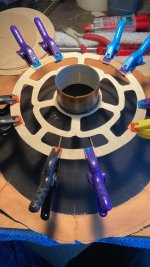 EEB451B4-B97F-4576-8BD8-967D343E263F.jpeg206.8 KB · Views: 273
EEB451B4-B97F-4576-8BD8-967D343E263F.jpeg206.8 KB · Views: 273 -
 69C1F7A7-22F4-42D4-96E8-BC640A049002.jpeg224.1 KB · Views: 275
69C1F7A7-22F4-42D4-96E8-BC640A049002.jpeg224.1 KB · Views: 275 -
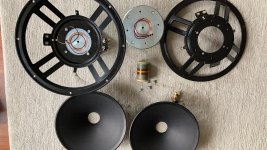 E6761666-CA7C-4A04-93DE-7ECE21CCF7C4.jpeg287.1 KB · Views: 261
E6761666-CA7C-4A04-93DE-7ECE21CCF7C4.jpeg287.1 KB · Views: 261 -
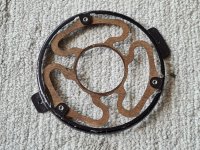 AC4B6277-3E72-4C2E-994C-03E8E69844FB.jpeg602 KB · Views: 277
AC4B6277-3E72-4C2E-994C-03E8E69844FB.jpeg602 KB · Views: 277 -
 9D870C20-E61F-4281-AD75-C3730B4677EA.jpg786.8 KB · Views: 178
9D870C20-E61F-4281-AD75-C3730B4677EA.jpg786.8 KB · Views: 178
Last edited:
Thanks for sharing these details. One of the more interesting projects I have seen here. I've been intrigued by field coil drivers. I never thought about innovating with the spider and the surround. I can only imagine the sound with the D3, triodes with interstage trafos and these gems.
Hi,
Sorry, no thread of this project. These speakers are a design that friends of mine and I are developing for years now, we improve something each year. I think we are nearing the last step of this concept.
@diyiggy: The parts are from EMS loudspeaker from France. I believe you are french?
A friend of mine used to be the importer for these units for benelux (and also Phy from France when Salabert was still alive) and we have good relations with them.
They deliver us the speaker parts from their field coil series and cones modified to our specifications and another friend of mine makes the spider and surrounds. It takes a lot of experimentation (lots of discarded designs) to get the best out of such a construction, but the result is worth it.
The big advantage of this kind of spider is that it reduces the cone distortion a lot; a common spider lets the cone move in all directions, this spider only provides movement on the cone axes, not sideways. If you hear the same 12” with standard spider and with the wooden one the difference is huge: much more focus, openness, less distortion (in the last picture: left one is standard spider, right one new spider)
The field coil is also a much better concept than a conventional magnet, there are 2 advantages; the magnetic field can be made much stronger and it stays constant (no dynamic loss due to the sagging magnetic field of a permanent magnet).
And the third advantage: you gan regulate the magnetic field with the power supply voltage (Q factor) to tune the response of the unit (this is a tweakers dream speaker😉 )
These techniques are old, the first cone loudspeaker was a field coil design and the wooden spiders were also used in units from the 1920s. The fifth picture is an old spider from Altec Lansing.
There is one disadvantage though: Once used to such a speaker you cannot stand the dull, distorted and colored sound of conventional units anymore........
Nice stuff, I recall someone in speaker fullrange forum who designed a driver with similar spider too but I think it was made with phenolic
@Supersurfer
Fascinating, thanks for sharing the photos. I'm very curious how they would sound!
@All
I've become more aware from peoples comments/experiences here and via PM that the D3 is a challenge to work on mainly because of the size of some of the components used. This got me thinking that maybe there would be interest in a less challenging through hole design. So I've put up a poll asking 'Would you like a through hole version of the D3?' If there is sufficient interest I would consider working on this. I'm curious as to how this will affect the sound. My feeling is that it may not sound as good, purely from there being bigger parts hence bigger current loop area, will it matter? -im not sure but I think it will be interesting to find out.
Fascinating, thanks for sharing the photos. I'm very curious how they would sound!
@All
I've become more aware from peoples comments/experiences here and via PM that the D3 is a challenge to work on mainly because of the size of some of the components used. This got me thinking that maybe there would be interest in a less challenging through hole design. So I've put up a poll asking 'Would you like a through hole version of the D3?' If there is sufficient interest I would consider working on this. I'm curious as to how this will affect the sound. My feeling is that it may not sound as good, purely from there being bigger parts hence bigger current loop area, will it matter? -im not sure but I think it will be interesting to find out.
Everything is life is a catch 22 Ryan at the end its more about achieving a good compromise. With Smd you limit the tweaking with part especially caps. Yes yes gonna have lots guys flaming me for saying this. If this is not the case a question for you then, is the S1 still in your dac or are you listening to stock TDA & think that stock is just as good ????
Cheers
Cheers
Hi sumotan,
I have only one S1 chip, and in my current setup I need 2 chips for balanced output, so im using 2 Taiwan chips that have a very close build date. For me the sound difference between different 1541A chips is more a matter of refinement or how polished the sound is rather than a fundamental change in sound, not like going from I2S mode to Simultaneous mode or the effect that different master clocks have on the sound quality. Just my opinion.
I have only one S1 chip, and in my current setup I need 2 chips for balanced output, so im using 2 Taiwan chips that have a very close build date. For me the sound difference between different 1541A chips is more a matter of refinement or how polished the sound is rather than a fundamental change in sound, not like going from I2S mode to Simultaneous mode or the effect that different master clocks have on the sound quality. Just my opinion.
Last edited:
- Home
- Group Buys
- DIY TDA1541A PCB "D3"
